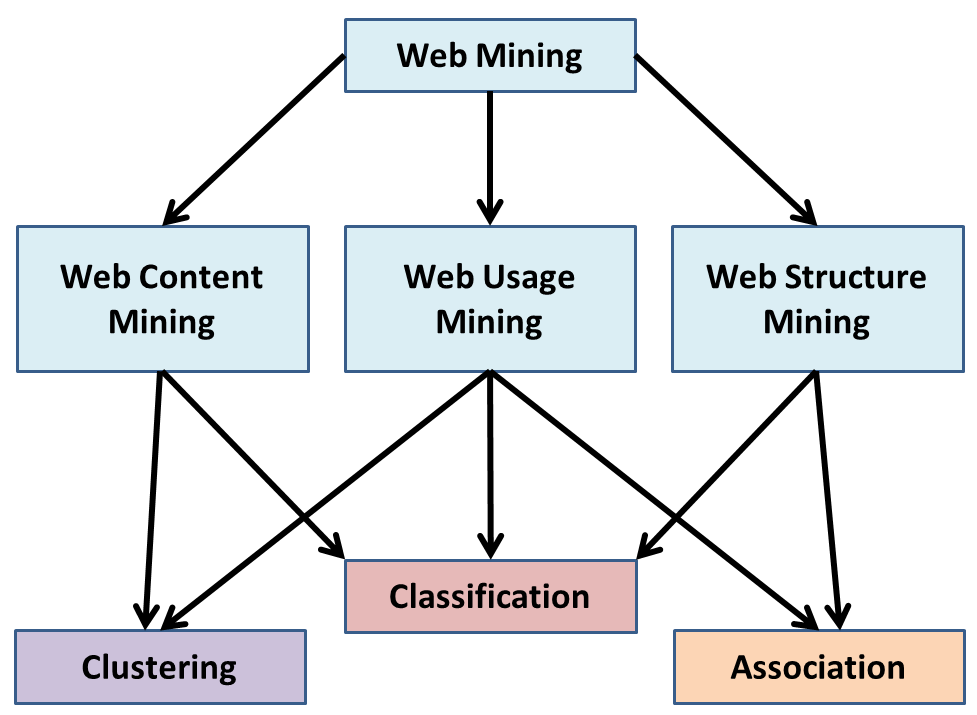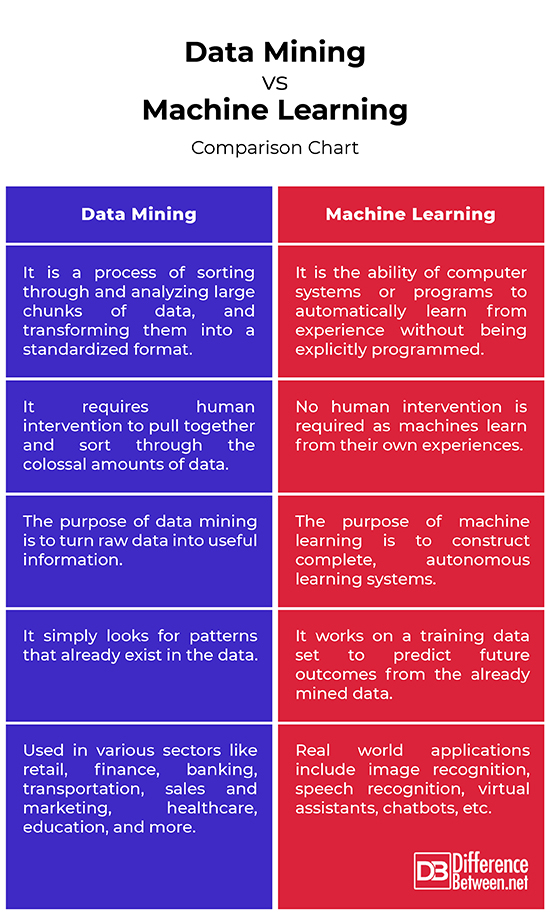Difference Between Data Mining and Machine Learning
Machine Learning is one of the most active research areas with Artificial Intelligence, which involves the study and development of computational models of learning processes. A major goal of research in the field of machine learning is to build computer systems that are capable of learning and acquiring knowledge on their own without being explicitly programmed. Data Mining is an area that owes much of its inspiration and techniques to machine learning. Therefore machine learning and data mining are often used synonymously, but rest assured, they are very different concepts with different goals.

What is a Data Mining?
In this digital age, every device that is connected to the Internet leaves some sort of digital trace and virtually all automated systems generate some form of data. On top of it, terabytes or petabytes of data are being generated daily from every aspect of our daily life. This explosion of data is a result of the digitization of our society and the increasing number of mobile devices, and the fast development of powerful data collection and storage tools. It is, therefore, necessary to analyze such data in order to generate some new information through data analysis. This is where data mining comes to the picture. Data mining is the process of sorting through and analyzing large chunks of data and transforming them into a standardized format. Data mining turns a large collection of raw data into useful information. The raw data is collected and stored in commercial databases and then analysts look for patterns in large batches of data using a broad range of techniques in order to obtain actionable insights from them.

Machine Learning
Machine Learning is a branch of artificial intelligence (AI) based on the ability of computer systems or programs to automatically learn from experience without being explicitly programmed. Learning is a multi-faceted phenomenon. Similarly, the computer modeling of learning processes in their multiple manifestations constitutes the subject matter of machine learning. This is one of the most active research areas within AI, which involves the study and development of computational model of learning processes. The objective of machine learning is to build computer systems capable of acquiring knowledge on their own and improving their performance from their own experiences. In real world, we can see the adaptation of machine learning techniques in areas like chatbots and voice-based virtual assistants. Machine learning involves processing the data to look for trends or patterns, which further helps in understanding the process. The process can then be used to predict the user behavior.
Difference between Data Mining and Machine Learning
Basics
– Both machine learning and data mining fall under the field of Data Science, which makes sense as both has something to do with data. Both the processes help make sense of the data which further helps in solving complex problems. Both the terms can be often used interchangeably, which makes it difficult to distinguish them sometimes.
However, data mining is a more general concept which involves turning a large collection of raw data into useful information, whereas machine learning is an all-encompassing term which involves processing the data to look for trends or patterns.
Purpose
– The two primary goals of data mining in practice tend to be prediction and description. On the predictive side, the goal of data mining is to use some variables or field in the data sets to predict unknown or future values of other variables of interest, whereas descriptive data mining focuses on understanding analyzed systems by identifying patterns and relationships in large data sets.
On the other hand, the purpose of machine learning is to construct complete, autonomous learning systems using a set of tools and techniques wherein intelligence is learned by intelligence and not induced.
Concept
– There is certainly an overlap between data mining and machine learning, but one key difference between the two is how the data is used. Data mining is the process of digging deep into vast amounts of data from multiple sources, extracting useful information from the data, and discovering patterns for predicting future outcomes.
Machine learning takes things further by using complex algorithms and data mining methods to build models consisting of mathematical formulas, decision criteria, and multi-dimensional parameters in order to predict the future outcomes without human intervention.
Analysis
– Data mining requires human intervention to pull together and sort through colossal amounts of data which may be arbitrary, unstructured, or even in a format that is immediately suitable for automated processing. The data mining analysts use broad range of techniques to sort the data drawn from various sources. The data is then collected, processed, and transformed into a standardized format for evaluation of future events.
Machine learning goes deeper, allowing machines and computer systems to learn from new data and acquire knowledge on their own without being explicitly programmed. So, no human intervention is required as machines learn from their own experiences.
Data Mining vs. Machine Learning: Comparison Chart

Summary
In a nutshell, data mining is the process of extracting information from a large amount of raw data which may be arbitrary, unstructured, or even in a format that is immediately suitable for automated processing. The data is then collected, processed, and transformed into a more standardized format. Machine learning, on the other hand uses strong analytical techniques to find valuable underlying patterns within the complex data to predict future outcomes. Machine learning is basically teaching a computer system to work autonomously without human intervention.
- Difference Between Caucus and Primary - June 18, 2024
- Difference Between PPO and POS - May 30, 2024
- Difference Between RFID and NFC - May 28, 2024
Search DifferenceBetween.net :
Leave a Response
References :
[0]Kantardzic, Mehmed. Data Mining: Concepts, Models, Methods, and Algorithms. Hoboken, New Jersey: John Wiley & Sons, 2019. Print
[1]Han, Jiawei, et al. Data Mining: Concepts and Techniques. Amsterdam, Netherlands: Elsevier, 2011. Print
[2]Aggarwal, Charu C. Data Mining: The Textbook. Berlin, Germany: Springer, 2015. Print
[3]Michalski, Ryszard S., et al. Machine Learning: An Artificial Intelligence Approach (Volume I). Amsterdam, Netherlands: Elsevier, 2014. Print
[4]Samudrala, Suresh. Machine Intelligence: Demystifying Machine Learning, Neural Networks and Deep Learning. Chennai, India: Notion Press, 2019. Print
[5]Image credit: https://commons.wikimedia.org/wiki/File:The_general_relationship_between_the_categories_of_Web_Mining_and_objectives_of_Data_Mining(English_version).png
[6]Image credit: https://live.staticflickr.com/1952/44405376514_f832e62fed_b.jpg
